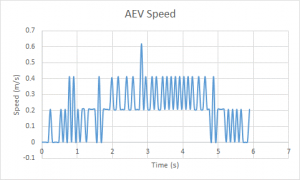Procedure
The next stage of developing the AEV involved performing an advanced lab involving energy analysis. The mass of the vehicle was weighed on a balance and recorded. Then, the vehicle was programmed to run at 30% power for 4 seconds. The vehicle was placed on the straight test track, and the start and stop positions were recorded. The Arduino data was then uploaded into the MATLAB Design Analysis Tool. The actual start and stop positions were compared to the EEPROM Marks read by the wheel count sensors. The difference between the actual marks travelled and the marks read by the sensors was considered to be the marks error. Once the marks error was determined, the friction and propeller forces were calculated using the data uploaded into the Design Analysis Tool. A provided Excel document obtained from Carmen was used to perform these calculations. Data from five other groups was obtained from the class instructor for comparison.
Results
The mass of the AEV was 268 g. Initially, incorrect data was used and the marks error was found to be 28. However, after doing another test run and using correct data, the marks error for the energy analysis lab was found to be under one, as the distance travelled almost perfectly matched the marks read by the reflectance sensors. The other aspects of this lab involved calculating the friction and propeller forces. The frictional force was calculated to be 6.2 gram-force (gmf). From this, the net force was calculated to be 2.9 gmf. Finally, the propeller force was the sum of the previous two forces, which turned out to be 9.1 gmf.

